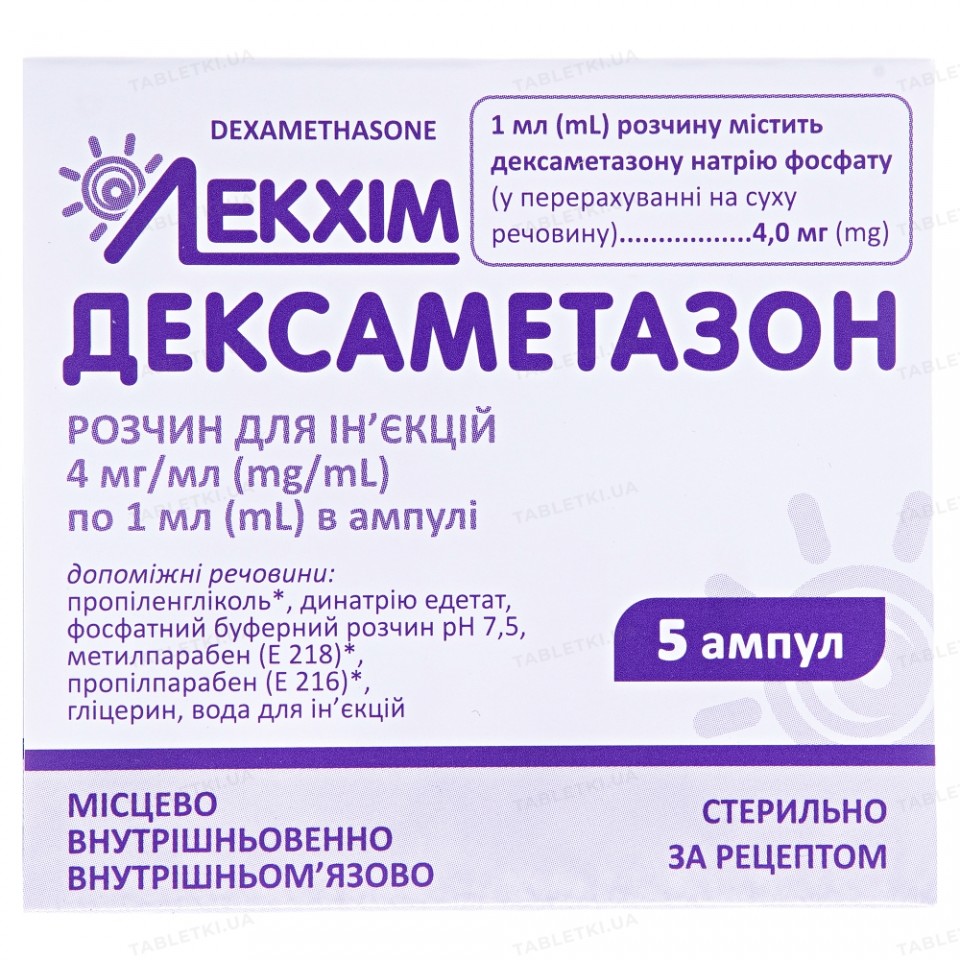
Dexamethasone
General properties
Corticosteroids for systemic use.
Dexamethasone is administered intravenously or intramuscularly in urgent cases and when oral administration is not possible.
- Diseases of the endocrine system: replacement therapy of primary or secondary (pituitary) insufficiency of the adrenal glands (except for acute adrenal insufficiency, in which hydrocortisone or cortisone is more suitable, given their more pronounced hormonal effect); acute insufficiency of the adrenal glands (hydrocortisone or cortisone are the drugs of choice, it may be necessary to use simultaneously with mineralocorticoids, especially when using synthetic anapogs); before surgery and in cases of serious injuries or illnesses in patients with adrenal insufficiency or with an undefined adrenocortical reserve; shock, resistant to conventional therapy, with existing or suspected adrenal gland failure; congenital hyperplasia of the adrenal glands; non-purulent inflammation of the thyroid gland and severe forms of radiation thyroiditis.
-
Rheumatological diseases (as an auxiliary therapy at a time when basic therapy did not work, that is, in patients with anesthetic and anti-inflammatory effects of NSAIDs were unsatisfactory): rheumatoid arthritis, including juvenile rheumatoid arthritis and extraarticular manifestations of rheumatoid arthritis (rheumatic lungs, heart changes , eye, skin vasculitis); synovitis in osteoarthritis, posttraumatic osteoarthritis; epicondylitis, acute nonspecific tenosynovitis; acute gouty arthritis; psoriatic arthritis; ankylosing spondylitis; systemic connective tissue diseases; vasculitis.
-
Diseases of the skin: pemphigus; severe erythema multiforme (Stevens-Johnson syndrome); exfoliative dermatitis; bullous herpetiform dermatitis; severe forms of exudative erythema; erythema nodosum; severe forms of seborrheic dermatitis; severe forms of psoriasis; urticaria, which is not amenable to standard treatment; fungoid mycosis; dermatomyositis.
-
Allergic diseases (not amenable to traditional treatment): bronchial asthma; contact dermatitis; atopic dermatitis; serum sickness; chronic or seasonal allergic rhinitis; allergy to medicines; urticaria after a blood transfusion.
-
Diseases of the organs of vision: inflammatory diseases of the eyes (acute central choroiditis, optic neuritis); allergic diseases (conjunctivitis, uveitis, scleritis, keratitis, iritis); systemic immune diseases (sarcoidosis, temporal arteritis); proliferative changes in the orbit (endocrine ophthalmopathy, pseudotumor); immunosuppressive therapy for corneal transplantation.
The solution can be administered systemically or topically (injection under conjunctive and retrobulbar or parabulbar injection).
- Gastrointestinal diseases (for removing the patient from a critical condition when): ulcerative colitis (severe development); Crohn's disease (severe development); chronic autoimmune hepatitis; reaction of rejection during liver transplantation.
-
Diseases of the respiratory tract: symptomatic sarcoidosis (symptomatically); acute toxic bronchiolitis; chronic bronchitis and asthma (with exacerbation); focal or disseminated pulmonary tuberculosis (together with appropriate anti-tuberculosis therapy); berylliosis (granulomatous inflammation); radiation or aspiration pneumonitis.
-
Hematological diseases: acquired or congenital chronic aplastic anemia; autoimmune hemolytic anemia; secondary thrombocytopenia in adults; erythroblastopenia; acute lymphoblastic leukemia (induction therapy); idiopathic thrombocytopenic purpura in adults (only intravenous administration - intramuscular administration is contraindicated).
-
Renal diseases: immunosuppressive therapy for kidney transplantation; stimulation of diuresis or reduction of proteinuria in idiopathic nephrotic syndrome (without uremia) and impaired renal function in systemic lupus erythematosus.
-
Malignant oncological diseases: palliative treatment of leukemia and lymphoma in adults; acute leukemia in children; hyperkapcyemia in malignant diseases.
-
Brain edema: cerebral edema due to primary or metastatic brain tumor, trepanation of the skull and craniocerebral trauma.
-
Shock: a shock that does not respond to standard treatment; shock in patients with adrenal cortex deficiency; anaphylactic shock (intravenously after administration of epinephrine), before surgery to prevent shock if suspected or with insufficient adrenal cortex deficiency.
-
Other indications: tuberculous meningitis with subarachnoid blockade (together with proper anti-tuberculosis therapy); trichinosis with neurologic symptoms or myocardial trichinosis; cystic tumor of the aponeurosis or tendon (ganglion).
Indications for intraarticular administration or introduction into soft tissues: rheumatoid arthritis (severe inflammation of an individual joint); ankylosing spondylitis (when the inflamed joints do not respond to traditional treatment); psoriatic arthritis (oligoarticular form and tenosynovitis); monoarthritis (after evacuation of synovial fluid); osteoarthritis of the joints (only in the case of synovitis and exudation); extra-articular rheumatism (epicondylitis, tendovaginitis, bursitis); acute and gouty arthritis.
Local administration (introduction to the lesion): keloid lesions; hypertrophic, inflammatory and infiltrated lesions in lichen, psoriasis, ring-shaped granuloma, sclerosing folliculitis, discoid lupus and cutaneous sarcoidosis; disk red wolfish lichen; Urbach-Oppenheim disease; localized alopecia.
Hypersensitivity to the active substance or to any other ingredient of the drug. Acute viral, bacterial, or systemic fungal infection (if you not to apply the proper therapy). Cushing's Syndrome. Vaccination with a live vaccine. Lactation (except for urgent cases). Intramuscular administration is contraindicated in patients with severe blood clotting disorders. Topical administration is contraindicated in bacteremia, systemic fungal infections in patients with unstable joints, infections at the site of application, including in septic arthritis due to gonorrhea or tuberculosis
Pharmaceutical characteristics
Clear, colorless liquid.
Keep out of reach of children in the original packaging at a temperature not exceeding 25 °C.
